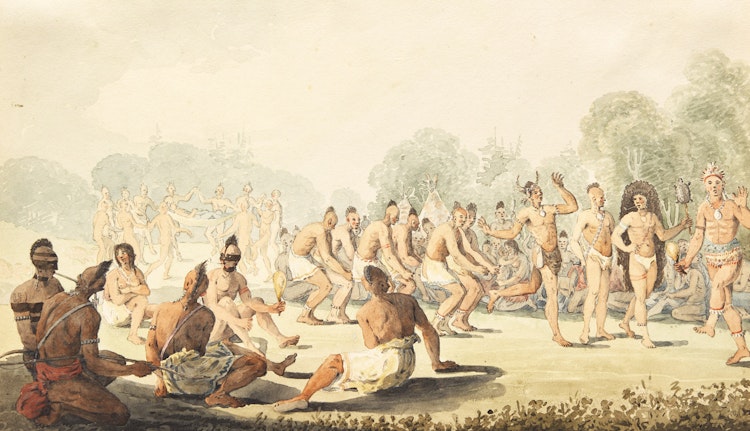Dance for Recovery of the Sick by George Heriot

George Heriot
Dance for Recovery of the Sick
watercolour over graphite on paper
signed, titled and dated 1805 in the lower margin; unframed (matted)
7.75 x 11.75 in ( 19.7 x 29.8 cm ) ( sheet )
Auction Estimate: $1,000.00 - $1,500.00
Price Realized $7,800.00
Sale date: April 22nd 2025
Joseph Pariseau
Gifted to Mrs. E.K. Burnett by her uncle, Henry Pariseau (as wedding gift), 1934
Kennedy Galleries, New York, 1967
Purchased by the Art Gallery of Windsor by special subscription with the assistance of the Canada Council, 1967
Collection of Art Windsor-Essex
"George Heriot: Painter of the Canadas", Agnes Etherington Art Centre, Kingston, 12 November - 31 December 1978
'White, Red, and Black: The Wyandot Mission at Upper Sandusky', "Timelines, A Publication of the Ohio Historical Society", May/June 1996
"Crossroads - Civilization Book II," Prentice Hall Canada Inc. 1998 (Grade 9 Highschool Textbook), Canadian Pathfinders Series, 1989-1990
Robert Craig Brown, "The Illustrated History of Canada", Toronto, 1987
Gerald E. Finley, "George Heriot: Postmaster-Painter of the Canadas", Toronto, 1983
"The Kennedy Quarterly", Kennedy Galleries, Vol VII, No.2: 1967
William S. A Dale, "Nine Watercolour Paintings by George Heriot (1766-1844) in the Collection of Willistead Art Gallery of Windsor", Windsor, 1967
Gerald E. Finley, "George Heriot" Ottawa, 1979
Share this item with your friends
George Heriot
(1759-1839)
George Heriot, artist, public official, writer (b at Haddington, Scot 1759; d at London, Eng 1839). His chief importance to Canada resides in his art. He developed his drawing skills at an early age, encouraged by the Scottish Maecenas, Sir James Grant of Grant. In 1777 Heriot sailed for the West Indies, where he drew and composed A Descriptive Poem, written in the West Indies (1781). On his return to Britain (in 1781), he attended the Royal Military Academy, Woolwich, receiving instructions in topographical drawing from the illustrious drawing master, Paul Sandby, from whom he likely learned the principles of the Picturesque, an aesthetic system that determined his approach both to descriptive writing and to art. In 1792 he arrived in Canada employed as a clerk in the Quebec Ordinance Department; in 1799 he was appointed head of the Canadian post office. During his long Canadian sojourn (1792-1816) he returned to Britain twice on leaves of absence - in 1796 and in 1806. On the first return visit he seems to have been deeply impressed by the simplicity and monumentality of recent British watercolours and prints. It was also on this visit that his watercolours were accepted for exhibition at the Royal Academy.
Though talented as an administrator, Heriot lacked the diplomatic skills that would have led to his promotion and to more power in the colony. However, he often found refuge from the tensions of his duties in travelling, writing, and painting. He wrote The History of Canada from its first discovery (1804) and Travels through the Canadas (1807), this latter work is illustrated with mainly aquatint plates of landscape, native and habitant subjects based on his own watercolour designs. In 1816 he resigned from the post office (owing to increasing difficulties with the colonial administration) and returned to Britain.

